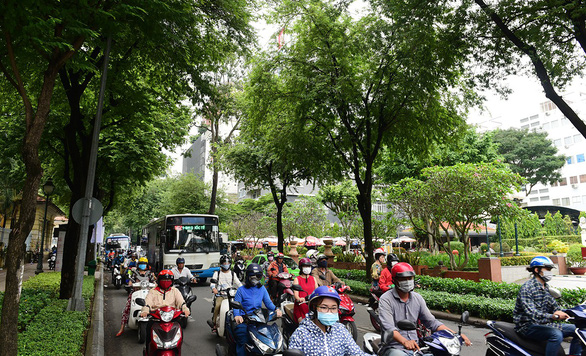 Society
Society


|
| Electrical cables on Nam Kỳ Khởi Nghĩa Street in HCM City's District 3 have been buried underground. — Photo from tuoitre.vn |
HCM CITY — Electrical and telecommunication cables in District 1 and 3 will be buried underground by 2020, the city has announced.
The city has already buried over 480km of medium-voltage and 380km of low-voltage power lines underground, according to the HCM City Power Corporation under Electricity of Việt Nam (EVN HCM City).
Cables have been buried or placed in small cabinets on median strips on major streets such as Tôn Đức Thắng and Hàm Nghi in District 1 and Điện Biên Phủ and Nam Kỳ Khởi Nghĩa in District 3.
Phạm Quốc Bảo, general director of EVN HCM City, was quoted as saying in Tuổi Trẻ (Youth) newspaper that burial of electrical cables was one of the city authorities’ key projects to ensure safety, prevent electrical incidents, and make the city clean and civilised.
EVN HCM City has also set up a surveillance system that will help resolve electrical incidents within at least five minutes. A technical system will shut down power in three seconds if cables break, he said.
The surveillance camera system helps to manage road digging and ensure that streets are clean after the burials of cables. In the near future, robots will be used to dig up streets and bury electrical cables.
EVN HCM City has worked with the city’s Department of Information and Communications to ask telecom companies work with the company to bury cables concurrently, according to Bảo.
The city has placed nearly 2,800km of electrical cables underground, accounting for more than 39 per cent of medium-voltage grids and more than 14 per cent of low-voltage grids as part of a project that began in 2011.
Between 2011 and 2015, 358km of medium-voltage and 620km of low-voltage cables were buried underground.
Since 2016, at least 568km of medium-voltage and 985km of low-voltage power lines have been buried, completing more than 86 per cent of the 2016-2020 target.
By 2025, the city targets burying all electrical cables in central districts, administrative centres in suburban districts, new urban zones, and industrial zones. — VNS




